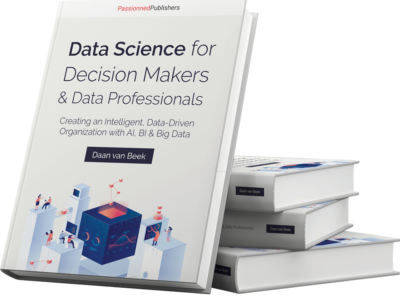No more sacred cows
Data analysis, and data-driven working in particular, enables organizations to make the most of their improvement potential. But in order to live up to their fullest potential, some proverbial sacred cows will have to be sacrificed on the altar of progress. So says Daan van Beek, founder of Passionned Group and author of management books such as Data Science for Decision-Makers. The idea of BI as a separate department, for example, is a thing of the past. “But that’s okay, because change releases new energy,” according to Van Beek. “The walls of old between BI specialists who make static reports and business managers have to be broken down. One thing is certain: if the passion and the will aren’t there, data-driven working will never really take off”, Van Beek explains. He’s quick to add that you shouldn’t paint every BI manager with the same brush, of course.
The core of data-driven working
“In everyday practice, most organizations still put too much emphasis on gathering data, generating reports, and making dashboards available to users and the business. But that’s not the core of data-driven working and BI.” Van Beek suggests an alternate approach that he says is much more dynamic, exciting, fun, and effective. “Discover what data means to your work, your daily functioning, the future, and the organization’s performance. Try to use data to discover how processes run and people function. Stay curious and gain knowledge and valuable insights. Ask yourself how you could improve things.” Once the points of improvement have been embedded in the process and established as the new standard, there’s still more work to be done, according to Van Beek. “We’re talking about continuous learning and improvement, including single, double, and triple loops.”
Break down the wall
“In our role as advisors, we can clearly see the differences between ‘old-school’ organizations and the more modern, data-driven establishments. The biggest difference is that the data-driven organizations have successfully broken down the wall between the Business Intelligence department and the business. They’ve reorganized old departments and created new entities. Successful, modern BI departments are embedded in the operation. Business analysts, team leaders, managers, and BI experts all work together. Sometimes there may still be a very small barrier between them, but that’s it.”
Data is the new gold
“Modern, data-driven organizations realize that their data is a valuable asset. Data is the new gold. That’s why every BI organization and Data Science specialist should sit down with the users to determine what the data actually means. Analyze data together, and not as a one-time thing, but continuously. These kinds of sessions and discussions usually result in valuable insights and realizations about how things really work. You’re looking for correlations or causal connections between certain events. Sometimes, this can result in a genuine Eureka moment, a real revelation.
The status quo won’t help you
“Most BI departments make reports available, but unfortunately those don’t always contain deep insights, or users fail to extract those insights. Ideally, in a data-driven organization, the business should constantly be generating valuable insights that support effective and efficient operation and, last but not least, make the organization more intelligent. Traditional reports and dashboards provided by most BI vendors reflect the status quo. That’s not much help when solving problems,” Van Beek says, speaking from experience.
A spark of inspiration
“Data-driven working is essentially nothing more than the driving force of data helping you to reach your goals. You can research a particular phenomenon because you’re trying to reach your goal more quickly. Decisions are led by data. All this fits within the broader definition. Being driven means being motivated by individual passion. And that passion came into being because of a spark of inspiration. This was the case for the winner of the Dutch BI & Data Science Award in 2015, the Safety Region Noord-Holland Noord, who managed to greatly reduce the lead time of heart patients thanks to data.”
Daan van Beek, the author
Daan van Beek has written several management books, including the international bestseller Data Science for Decision Makers.
The Data Science book for Decision Makers & Data Professionals  Daan van Beek literally wrote the book on Data Science and intelligent organizations. Data Science for Decision-Makers and Data Professionals covers all the essential basic principles, organizational processes, architectures, tools, and conditions needed to create a truly Intelligent, Data-driven Organization. Learn to make better decisions faster, on every level of your organization.
Daan van Beek literally wrote the book on Data Science and intelligent organizations. Data Science for Decision-Makers and Data Professionals covers all the essential basic principles, organizational processes, architectures, tools, and conditions needed to create a truly Intelligent, Data-driven Organization. Learn to make better decisions faster, on every level of your organization.
Data is everywhere
“These days, data is ever-present. But there was data before there was mankind, too. Single-cell organisms picked up signals and reacted to light. The micro-organisms that formed the first of Earth’s ecosystems, for example, didn’t like sunbathing. They wisely kept to the shadows when the sun was too strong. There was no protective ozone layer yet. That’s how the first data processors were born,” Van Beek says. “In meaningless, binary forms, data is embedded in the hearts of our computers, and data is meaningfully embedded in management information systems, dashboards, and annual reports. Data streams through laptops, phones, company networks, machines, cars, but also people, animals, buildings, and public spaces.” But data alone doesn’t get you very far, according to Van Beek. “It’s all about connecting data.”
Start a chemical reaction
“The biggest value of data-driven working and using BI is created when you start to connect or link data, creating new insights. You’re hoping for something like a chemical reaction. Hydrogen, for example, is colorless, odorless, and flammable. But hydrogen can connect to many other elements. Hydrogen and oxygen create water, H20. This releases a lot of energy. And for a lot of people, water is as valuable as gold.” After this short sojourn into chemistry, Van Beek says we can draw some important conclusions:
- Data-driven working releases a lot of energy.
- Whether it’s a spark of inspiration or a chemical reaction, the role of people remains crucial. People have to be motivated by data.
- The status quo in organizations has to be broken down.
- Static reports won’t win the battle, and will never allow data-driven working to take off. You’ll have to invest time and money in data analysis tools, self-service BI, and discussions about the data.
Mental map
There are more parallels. In biology, we can see how processing, analysis, and interpretation of biological data leads to the unraveling of the human genome, the so-called book or code of life. Professor of bioinformatics De Ridder (2015) says it’s important to build a complete mental image of the problem and the data structures and the algorithms representing it on the computer. Data-driven working travels a similar path: from data to information, from information to knowledge, and from knowledge to understanding. Or, like Richard Feynman said: “What I cannot create, I do not understand.” In other words, we can only say we understand a motorbike when we can build one ourselves.
Van Beek says that the fear of algorithms blindly and automatically making wrong decisions is unfounded. “Take breast cancer diagnosis, for example. The doctor doesn’t make that call anymore, but the algorithm does. But does that make the doctor obsolete? Not at all, their role will just change. The doctor will become the steward of the algorithm’s quality, they’re going to train the algorithm and keep improving it. We’re talking about supervised learning.”
Four conditions for data-driven working
According to Van Beek, there are four conditions required to successfully implement data-driven working:
- Strategy. “Data-driven working once a year doesn’t work. Data-driven working has to be formally embedded in your organizational strategy, and data has to be considered an asset. There are clear signals that leaders and employees who don’t embrace data-driven working will eventually be replaced by people that do.”
- Understanding and awareness. “Realize that data-driven working will not only help you reach your goals, but also enable you to offer higher quality service to (internal) customers. It could provide million-dollar insights.”
- Training. “Managers have to teach their employees to experience the added value of data-driven working. Data literacy is a core competency. Invest in your people’s skills.”
- Go for it! “Get to work. Organize short-cycle improvement sessions and ensure that improvements are secured in the process. If you want to prioritize data-driven working, genuine KPIs are essential. But don’t define too many KPIs, or people won’t see the forest for the trees.”
Van Beek shares one last tip: “For every dollar you invest in technology, hardware, or software, also invest one dollar in training and coaching. People have to learn to look critically at data and algorithms and learn to interpret and analyze it. In other words, they have to become data-literate.
Avoid definition issues
Organizations that try to find their way through the jungle of management jargon will quickly miss the forest for the trees. Data-driven steering, data-driven working, information-driven working or steering, all mean more or less the same thing, but the devil is in the details. Definitions are useful to get the discussion started, according to Van Beek. “The term ‘datacratic’, for example, is also becoming more popular. It literally means ‘led by data’. Datacratic working is a slightly more refined take on data-driven working that really gets at its essence.”
Next step
“Take the next logical step: break down the psychological and physical walls between the BI discipline and the business. Reorganize the tasks, responsibilities, and authorizations. Realize that successful, modern companies like Netflix have completely embedded BI and AI in their business operations.”
Contact Daan van Beek
Do you want to make your organization more intelligent and implement data-driven working in practice? Contact Daan van Beek, international speaker, trainer, and author.


